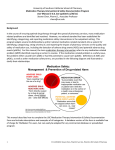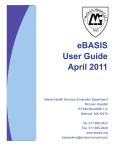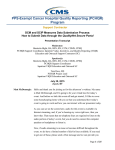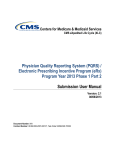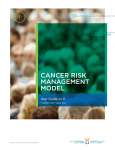Download AM Q&A - Quality Reporting Center
Transcript
Hospital Outpatient Quality Reporting Program Support Contractor Submitting Web-Based Measures Through the Portal: Questions and Answers June 18, 2014 10:00 a.m. ET Moderator: Mollie Carpenter, RN BSN Educational Coordinator, Hospital OQR Program SC Speaker: Marty Ball, RN Project Coordinator, FMQAI Question 1: Hi, this question is in reference to Outpatient 29 and 30. When you said that the population was a voluntary fill-in, is that also the case for the sample size? Answer 1: The sample size of … Do you mean like Population and Sampling? Question 1: Under the population heading it asks your total inpatient population and then it says, “What was your hospital sample size?” Answer 1: Yes, that would be voluntary. Question 1: Okay, thank you. Question 2: Hi, I’m calling regarding -- or my question is regarding the Portal. You said it wouldn’t be available until July 17, is that correct? Answer 2: That’s correct. So the Portal -- they’ll be introducing the new system that was supposed to go on July 1, but it’s been pushed back to July 10 when they’ll start introducing the new system, and they anticipate taking seven days to roll out this new system. So, from July 10 at 8:00 a.m. Eastern Time, the legacy system or My QualityNet will be unavailable until the 17th. So when you’re entering data for -- because some deadlines are approaching, keep that in mind to enter early. Question 3: Hi, thank you. Outpatient 27, the Influenza Vaccination Coverage among Healthcare Personnel, what if we’re already submitting our data to NHSN? Page 1 of 13 Hospital Outpatient Quality Reporting Program Support Contractor Answer 3: Then that’s good, because you already have an account set up. The way it’s been described to us is that because the Outpatient and Inpatient will be merged and entered as one number, you’ll go on to your regular account that you have, you’ll select “Inpatient” and that’s where you’re going to enter the data for OP-27. Question 4: Hi, I have a question about the Portal. Is our first data for Inpatient being submitted through the new Portal, or do we go ahead and submit it through the old QNet? Answer 4: It would depend on the date that you are going to submit your data. If you submit prior to July 10, then you’ll use the old system, and after the 17th you’ll submit using the Secure Portal. Question 5: Hi. Can you please tell us how to get the slides out again? I must have missed a step because it won’t go there. Answer 5: Okay. To retrieve the slide pack, you’re going to go to oqrsupport.com and look under the “Education” link, and there you’ll find the slide packs, which will be listed as one or three per slide, and you can download those and print them. Question 6: Hi. Can you hear me? Answer 6: Yes. Question 6: My question -- I just really don’t comprehend the amount of -- we have a contract company, okay, so that’s helpful, but what is the total number of required episodes for OP-29 and OP-30? Is it for the year; is it based on the quarter; is it based on the month? How do you know how many you need to submit? Answer 6: It’s going to be based on an annual total. The specification guide has a separate population and sampling set for those measures, for the webbased measures, and they have -- if you have 0 to 900 patients that had OP-29 and then 0 to 900 that had OP-30, you’re going to enter 63 for each of those measures. Since they’re separate measures, you’re looking at them as two different entities. If you have over 901, then you’ll enter 96 patients, which will be your annual population. CMS has said that they’re not concerned how the population is gathered, whether you gather it monthly, quarterly, annually, and the – it’s not truly a random sample. If you take a sample from the first month that you start the procedures, they’re considering that a sample, and that’s adequate. Page 2 of 13 Hospital Outpatient Quality Reporting Program Support Contractor Question 7: Yeah, we had a question about the actual mechanics of submitting the data. Are we able to submit the data and say there’s a data entry error? Can we go back during the entire submission period and change that, or is it locked out in the new Portal once we submit the data? Answer 7: Well, I have one of the experts and developers from PMBR, Chris Truman, so let me turn that question over to Chris. Answer 7: Thanks Marty. Anytime during the submission period you will be able to go in and modify any answers that you may have answered incorrectly. Question 8: I’m going to go back to the Influenza Vaccination of Healthcare Workers, and I, too, submit to NHSN. What I didn’t hear before in the other participant’s question was if we will need to confer rights. Answer 8: I’m not sure what you’re asking, confer rights? Question 8: Yeah, because right now for NHSN, I’m in Iowa, and I confer rights to the Iowa Department of Public Health so they can see what our numbers are. I confer rights to our health system that we’re in so that they can see what our numbers are. So how will you pull from NHSN, or are we going to have to submit it twice? Answer 8: I believe you’re going to have to submit it twice because that’s a state requirement. So I’m not – we’re -- what your state requires you to do is going to be different nationally throughout the nation. Answer 8: Are you submitting -- this is Reneé. Are you submitting Inpatient currently, for the Inpatient measure? Question 8: Yes. Answer 8: Okay, then. If you are submitting from an Inpatient perspective, that will come across and will auto-populate for your Outpatient. So, I would not anticipate that you would need to confer rights to anything else because the CDC sends a file over for your Inpatient currently. But we will follow-up on that and post -- push something out if we find out something differently. But if you are currently answering for Inpatient, you should not need to do anything extra for that to work for the Outpatient as we currently understand it. Did that answer your question? Question 8: Yes, I guess – and on the screen, if we could go back to the slide that talks about that measure, you’re asking for healthcare worker influenza vaccination rates divided by Inpatient and Outpatient? Page 3 of 13 Hospital Outpatient Quality Reporting Program Support Contractor Answer 8: No, they’re going to be entered as one number. Initially when the measure was created, they had thought about separating the Inpatient and Outpatient within a facility, the staff, but they found that that wasn’t really -couldn’t really be done because too many of the Outpatient workers worked in the Inpatient. What they decided to do was have one data entry number and that number is going to be entered on Inpatient. I don’t anticipate there would be any difference from the way you were having your rights go to the State of Iowa now than it would be when this data is entered, because it will still be entered under the Inpatient. Question 9: Sorry about that. I wanted to double check about what was the code that you mentioned with OP-22 when you were determining -- it’s a little bit confusing when you say that you have these patients that have come in and they were not being seen, and you were talking about the variants of coding. Answer 9: Right, well I was talking about discharge code. So they would be coded as “Unable to Determine” for the discharge code. What we found is that initially when OP-22 came about, and it was kind of a separate population; we thought that, well, people could probably keep track of that through a log book in their ER because for those patients, the guidelines of the Specifications Manual state they’re registered, but then they’re not seen by the provider. So if the patient is seen, they go sit in the ED lobby, and leave – then we thought those would probably go into OP-22. Well, if a facility then charges that patient and assigns him an E&M code, that made them eligible for the Throughput measure. So then people started finding these patients in their ED Throughput that basically, as I described, came in, were registered, sat down in the ED lobby and left, and they were like, “Well, what do we assign as our discharge code for this patient, because for the ED Throughput measure you have to have a discharge code?” Since you don’t know where they went or what time they left, “Unable to Determine” is going to be the discharge code (Number 8). Question 10: Hi, I just wanted to clarify the submission of the Influenza for Healthcare Workers once again. We have an infection control nurse who sends that information to the NHSN, but then I still – if I’m right – you’re saying I still need to go in and submit that through the Outpatient measures, is that correct? Page 4 of 13 Hospital Outpatient Quality Reporting Program Support Contractor Answer 10: No, nope. All the information for the influenza vaccine is going to be entered on the CDC website, and so if your infectious control nurse is currently doing that, there shouldn’t be any difference next year in how it’s done. It will be following the guidelines, and the Oklahoma Foundation for Medical Quality did just release a fact sheet on QualityNet for the influenza vaccine. Wanda, can you tell them where to find that? Answer 10: Yes. If you’ll go to either Inpatient or Outpatient Hospitals on the QualityNet website, in the left navigation bar there should be a link for fact sheets. I wanted to point out that the change really is that you’re including Inpatient and Outpatient personnel when you report your Inpatient number. That’s the difference, only. Then CDC will send a report to CMS so that you are not having to do anything extra. As far as reporting, you continue to do the same reporting to NHSN, it’s just that you need to include inpatient and outpatient personnel in this one aggregate number. And so the numerator is the number of all healthcare personnel working in both settings, inpatient and outpatient, who were vaccinated in the time frame, and then the denominator is the count of the healthcare personnel physically working. You will have a numerator and denominator, it’s just, you know, one is the numerator, those that got vaccinated, and then the denominator, of course, is the total number of personnel. Question 11: Yes. I’m going back to Slide 34 and 37 on OP-29 and -30. Although I understand that to enter a population, sampling is voluntary. If you do decide to enter that, the question is, what is your hospital’s total patient population? Is that really what you mean, or do you mean for that measure set? Answer 11: Chris, would you like that question? Answer 11: Sure. For the population information that’s being asked for this, it’s measure- specific. It would be the patient population for that measure. Question 12: Hi. This question may have just been answered, but I wanted to validate that for Outpatient 29 and -30; and also, you didn’t mention it, but for the cataract measure, those are voluntary. So if the system chooses not to enter any information, that that is just fine? Answer 12: No, the measures are not voluntary. It’s required that you answer the questions for OP-29 and -30, and if you don’t answer the questions, it could affect your annual payment update. For OP-31 that has been pushed back to January 1 of 2015 for data collection – and there will be more information Page 5 of 13 Hospital Outpatient Quality Reporting Program Support Contractor when CMS gives the webinar on the Proposed Rule in July, and then the Final Rule will come out in November with information about the cataract measures – but the data entry for OP-29 and -30 is, as is with any webbased measure, it’s a requirement that your facility answers that question. Question 13: Hi, thank you. I’m going to just clarify one more time that OP-29 and -30 you’re saying, are the colonoscopy populations for the initial population, not all surgical population? Answer 13: Correct, it’s measure-specific. I guess on that last question, the voluntary issue is just for the “population,” if it appears on the tool. But it’s a program requirement that the numerator and denominator are entered. Question 14: Yes, I had a quick question. I was actually in the Secure Portal today, and I don’t know if it’s because the system’s being worked on, but when I try to get in, I could get in, but then I got an error message that said “Because of inactivity your session has timed out and is no longer active,” and basically, it said “Click okay to reload the page.” I kept clicking “Okay” and the same error message came back up and said “Because of inactivity your session has timed out,” and it wouldn’t even let me log out. It did that for both of my ASC centers and the main hospital, so I didn’t know if that sounded something like was going on, on our end from IT, or if this is a common problem with the site right now. Answer 14: It’s not a known issue with the site, so I would recommend that you call the QualityNet Help Desk and let them know what the problem is, and they should be able to walk you through that. Question 14: Yes, I need the information repeated about the safe surgical checklist. Answer 14: Okay, the Safe Surgery Checklist will be answered along with all of your other structural measures [web-based measures] and this year the requirement is that “Did you use a safe surgical checklist for the full year of 2014?” So then, it will be answered for your facility, just a “Yes” or “No,” and there’s no requirement that there’s any surgical checklists that are placed in the record, the medical record. If you look at the Specifications Manual, the safe surgical checklist follows under three different points, and there’s an example on our website at oqrsupport with the World Health Organization’s Safe Surgical Checklist. Did that answer your question? Question 14: I didn’t know if there needed to be specific questions answered, or if there was just a safe surgical checklist period? Page 6 of 13 Hospital Outpatient Quality Reporting Program Support Contractor Answer 14: Just that there’s a safe surgical checklist, but the requirement for the Safe Surgery Checklist is that it follows three different areas while the patient is in the surgical suite: that the-- the period prior to administration of anesthesia, the period prior to skin incision, and the period prior to closure of incision and prior to the patient leaving the operating room. So if you look at the World Health Organization’s Safe Surgical Checklist, they break it down into those three different points, and that’s what CMS is requesting that the facilities follow. Question 15: Thank you. My question is regarding OP-29. We have started to try and do some chart reviews on these, and what we’re finding, and this is after looking at a couple of hundred cases, that only two of them actually met the numerator and the denominator because the majority of these patients had some kind of a finding such as a polyp or a (inaudible) and are then taken out of the measure. It looks like we’re going to have to look at so many records in order to meet the sample size, if at all. Answer 15: That -- I can understand where that can happen because they do find things commonly in the colonoscopies. One thing I would suggest that you might have your endoscopy nurses do is keep a tally in their department; maybe just write down a patient record number if they have a negative finding and that may assist you so that you’re not looking through all of those records. Answer 15: Or you could -- this is Mollie. You could use -- you can go to our website at oqrsupport.com, and there is a tool we have posted on the “Resources and Tools” tab which is the endoscopy tool for OP-29 and -30. It’s a combined tool. If there’s any way you can get your nurses maybe to use the tool, they could circle the information, and they would know that the patient had a biopsy or something done during the procedure, and then you would know not to abstract that chart. It might help with the burden of looking through all those patients. Did that help you? Question 15: What happens if we can’t meet the sample size? Answer 15: You would just submit all the patients that do meet the requirements and your numerator and your denominator. Question 16: Yes, thank you. I’m sorry if this is a similar question that’s been asked several times already regarding Slide 34, regarding the population of sampling for OP-29 that needs to be submitted. Say, for example, you know from your billing computer system that you had 800 patients that were at least age 50, and by the CPT codes and the modifiers these patients had this procedure. I was under the impression that to determine the population that you had to follow the abstraction tool that was developed by a contractor and bank it all the way to Question 2. Page 7 of 13 Hospital Outpatient Quality Reporting Program Support Contractor So, are you saying then, to determine the population, you’re going to have to abstract every single patient to determine -- so I’m trying to find the difference between the initial population and the sample size that we’re supposed to enter here because I thought the purpose of the sampling was to decrease the burden for the hospital to not have to abstract every chart to determine what the denominator population is supposed to be. Answer 16: Right, your denominator population is going to be what you base your numerator and denominator on. So those are the patients that are going to be into the measure, if they’re greater than 50 years old they have this specific CPT code and the modifiers that don’t exclude them, and then the denominator exclusions. So once they make it through that, that’s where you’re going to have your denominator of either 96 or 63, depending on the number of colonoscopy procedures that were done. So when it asks what’s your patient – your hospital’s total initial patient population – they’re looking at what would be your number of colonoscopies that you did that fall into that category, and Chris, if you can back me up on this? Answer 16: Yeah, that’s true. That’s correct. Answer 16: Then your hospital sample size would be the 63 or 96, depending on what your annual patients that had the -- met the denominator criteria. Answer 16: Does that answer… Operator: No, go ahead. Answer 16: Go ahead. Question 17: Our question was answered. Thank you. Question 18: Hi, my questions back on OP-29 and -30. I still don’t understand when the word voluntary is being used, I guess that’s what’s throwing me off. What does voluntary mean? I thought if we have to answer them, what is voluntary? Answer 18: Okay, on the slides for OP-29 and -30, these are preliminary tools that were created for us so we could give you an example of what you would be answering next year for those measures. The population was placed on there by the creators, and the slides may change, that may come off, but if it remains on there -- because the rule doesn’t state that the facilities have to enter the population, it just states that they have to enter the numerator Page 8 of 13 Hospital Outpatient Quality Reporting Program Support Contractor and denominator. Therefore, the population, if it’s on the slide at the time, so if you have to answer, it will be voluntarily submitted, but not the numerator and denominator, they’re not voluntary at all. Answer 18: This is Jim Grant, I’m the Project Manager, and part of the reason we put the population, you know, for the sample size and sample frequency on this slide is that some facilities do not do colonoscopies; they’re small facilities, they may have an ER, but they may not have outpatient suites. And so there is a way of marking that this is not applicable, that submission is not required. You can mark that, and then you would put “zeroes” in your numerator and denominator and without really having the confirmation of, indeed, you do not have any colonoscopies that would look -- the data would look very odd, to see a facility showing numerator and denominator as both having “zeroes.” You do have to put in a numerator and denominator for these measures. However, if you choose not to do the initial patient population, the sample size or the sample frequency, you will not be penalized. Question 19: Hello? Answer 19: We can hear you Jamie. Question 19: Hi, I actually have two questions. You had mentioned the tool for OP-29 and -30, where is that located on the website? Answer 19: That’s located on – if you go under “Hospital Outpatient,” and then select on the left-hand side, it will say “Resources and Tools.” Once you click on the “Resources and Tools,” it will open up another page and it’s under “Cataract and Endoscopy Tools.” The -- I think, I believe, it’s the very first link and it’s an OP-29 and -30 combined worksheet but there are several tools in that area on that website. [The link can be accessed here.] Question 20: Okay, my question has to do with the submission period of July 17 to November 1. So, if we have our data and we want to submit from the first through the 10th, we would just submit it in the old system, is that correct? Answer 20: That’s what we understand right now. Question 21: Good morning. Marty, I’m wondering if you could please repeat what you said on Slide 28? Answer 21: All right, okay so Slide 28 talks about the Outpatient Volumes on Selected Outpatient Surgical Procedures, and this is divided into nine organ systems. What you need to do is total all the surgical procedure codes in each organ Page 9 of 13 Hospital Outpatient Quality Reporting Program Support Contractor system and enter the total for each system. What I said was if you bill it, then count it. If you do the same procedure twice on the same patient and bill it twice – and I used an example of bilateral joint aspiration – then you’ll count the procedure twice. You’ll gather up all that information for each specific surgical procedure code – take that aggregate, for example, in the eye or gastro column – and you’ll enter one number in there. If your facility did not do any of those procedures, say you’re strictly a cataract procedure only, then you’ll enter “zero” for cardiovascular, “zero” for GI, as well as all the other procedures, that your facility did not do those. And the surgical procedure codes that we’ll be entering this year are located in the Specifications Manual 7.0b. There’s the list, and then you’ll be able to enter those codes in each of the organ systems. Question 22: My question is about the status of QualityNet as we see it today. It’s used for access to those Specs Manuals and a lot of education and tools. Will that remain the same? Answer 22: Yes. The QualityNet will remain the same, the only difference will be the Portal entry, so the legacy system that’s the My QualityNet where you have your specific sign-on to get into the secure area of QualityNet will change into the secure area of the Portal which, if you look at the homepage now, you have the sign-on at the top of the center of the homepage, whereas this is going to change over to the right-hand side where it says “Portal.” There’s some great resources I might add as well under that Portal, where if you have questions regarding the Portal user manual or entering multiple CCNs or your IDs, there’s some helpful tools there as well with that. Question 23: Oh yeah, I have a question about the registration for the new Secure Portal. I’m already the SecurityNet Administrator for HBIPS. I’ve already done the security clearance part; and my understanding is, is that being that, I’m the administrator this would automatically roll over into the Inpatient and the Outpatient? I just wanted you to confirm that, that there’s not a separate registration process I have to complete? Answer 23: No, that’s true for the Inpatient and Outpatient but if you were registered -- if you just had a Psych or an ASC, it depends on how QualityNet has you -- if you have a separate registration for Psych and a regular hospital facility then, that requires two separate entries on the QualityNet through the Portal. Psych, ASC, and I believe that’s it. Wanda do you want to … Answer 23: I’m sorry, I was not – I was multitasking. Page 10 of 13 Hospital Outpatient Quality Reporting Program Support Contractor Answer 23: All right, just he’s asking about multiple entries in the Portal, and Chris might actually be able to answer that question too, but if you’re already signed up in the Portal as an Inpatient, you automatically maintain the same status with your rights as an Outpatient as well. I believe the difference is the Psych facilities will have two separate entries and need to make a joint account, and the ASCs. Answer 23: And I’m not familiar with that so I don’t know that information. Answer 23: Okay. That is in the resource page underneath the Portal sign-in. There’s some documents that we have there that explain all that. Question 24: Yes, hi, good morning. My question is in regards to OP-29, OP-30. If we have an outside vendor who uploads the information to QNet, do I still have to go in to your required numerator and denominator – I lost my slide – area that I have to put in the data for OP-29, -30, or the outside vendor automatically puts those in? Answer 24: That’s strictly with your vendor agreement and how you have arranged that business agreement with them. But what we found is that most facilities, for the web-based measures, enter them themselves and don’t use the vendor to do that. But you would need to check with your vendor for that. Question 25: … 29 and 30. So if these are preliminary, we don’t have to enter anything during the submission period of the July through November time period, correct? Answer 25: This year, correct. Question 25: Yeah, so next year when we have to do this again, we will have to enter it at that time, just nothing right now? Answer 25: That’s correct, and you’ll be looking at data from April 1 to December 31 of 2014 to be entered into 2015 for the 2016 payment year. Question 26: Are there any exemptions for Critical Access Hospitals on any of these measures, or are they all required? Answer 26: Participation by Critical Access Hospitals is voluntary. You’ll be able to answer -- you can answer whatever you would like. You’re not paid under the Outpatient Prospective Payment System, so any participation by you is strictly voluntary. Question 27: My question was just answered. Thank you. Page 11 of 13 Hospital Outpatient Quality Reporting Program Support Contractor Answer 27: Thank you. Question 28: Yes, hello. I can’t seem to find the resources and the tools. It’s on QNet? Answer 28: No, I’m sorry. It’s on www.oqrsupport.com. Answer 28: And that’s actually our website as the Support Contractor for the Hospital Outpatient, so there’s information on the QualityNet and then there are also a lot of tools and resources we’ve developed, because QualityNet is CMS’ website, so this is a separate website for the Hospital Outpatient Program. Question 29: My hospital gets to submit data through Truven Health, and the data is now showing up for OP-29 and -30. Will that be my numerator and denominator? Is that where I will get my information from? Answer 29: You would have to check with your vendor on that. I’m not -- because I’m not sure how you would have entered that data with your vendor, you know, whether you’re using a tool, demographics, what exactly or how they pulled that data; but that would be a question for them, and they may be able to supply you with the numerator and denominator. But keep in mind this is – OP-29 and -30 won’t be answered this year, they’ll be answered next year. Question 30: Hi. I know somebody else already asked about vendors and submitting the web-based measures automatically, but with the switch over to the Secure Portal, if we have a vendor that automatically populates for the regular Inpatient and Outpatient core measures, will they be able to continue to do that with the Secure Portal, or do we have to check with them to make sure that they’re enrolled and able to do that? Answer 30: I would, to be safe, check with them that they’re enrolled. The vendors are enrolling, and I’m thinking around 50 percent, 55 percent are signed up now in the Secure Portal. But keep in mind, as we always say here, is that the hospitals are ultimately responsible for submitting their data so you can’t count on -- you know, if there’s a mistake from your vendor, the hospital’s going to pay the price for that if it’s a late submission or a non-submission. Question 31: Thank you, sir. Hey Marty, just a quick question, if you could clarify about the old QualityNet versus the new Portal and the dates. I think I may have misheard you say that the new Portal will be available July 17, and the old QualityNet will be available up until the 10th of July, so there’ll be a week downtime; did I hear that incorrectly? Answer 31: Nope, you heard that correctly, and they’re actually going to start implementing the new Portal July 10 at 8:00 a.m. Eastern Time, so I Page 12 of 13 Hospital Outpatient Quality Reporting Program Support Contractor wouldn’t expect it to be available July 10. I would -- if you need to move anything or get anything out of the Portal or enter data, you’ll want to have it done by the morning of July 10. Question 32: I think that just answered my question. My administrator, she cannot enter any new data until July 10. Answer 32: Well, you can enter data on the old QualityNet system up until July 10 or July 9, the morning of July 10, and then the system will be shut down for all data entry, for pulling reports, for accessing your mailbox, for anything that you would have access to in the My QualityNet will not be available until the morning of the 17th. Question 33: Yes, I’d like to know – I have a nurse who does the chart abstractions through our CART program, and does she need access through the Secure Portal? Answer 33: She should have access to the Secure Portal. Mollie Carpenter: All right, well this concludes our program for today. I’d like to thank all of our speakers and participants for the valuable information and questions that you provided. We hope you have heard useful information that will help you with your Hospital Outpatient Quality Reporting Program. Please remember that you will not receive the program evaluation survey for your CE credit today. If we did not get to your question please use the question and answer tool located on QualityNet.org; a Hospital Outpatient Quality Reporting Subject Matter Expert will send you a timely response. Thank you again and enjoy the rest of your day. END This material was prepared by FMQAI, the Support Center for the Hospital Outpatient Quality Reporting program, under contract with the Centers for Medicare & Medicaid Services (CMS), an agency of the U.S. Department of Health and Human Services (HHS). The contents presented do not necessarily reflect CMS policy. FL-10SOW-2014FZ4T11-7-573 Page 13 of 13













